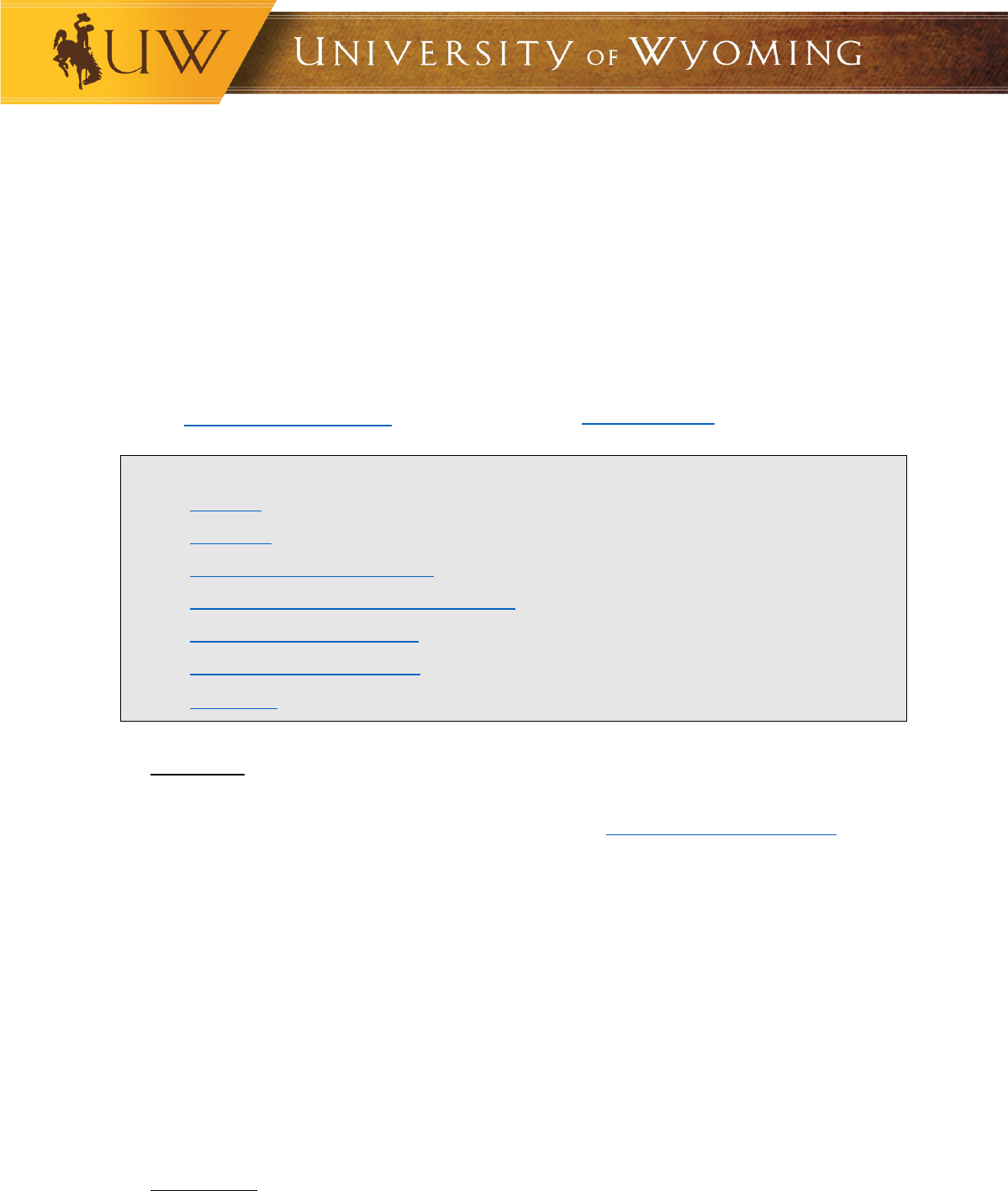
Business Process Guide
Procuring Goods and Services Process
[July 2023]
Questions about the Guide’s procedures?
Contact:
Procurement Services
Merica Hall, Room 115
Phone: (307)766-5233
Email: procurement@uwyo.edu
Questions about the Guide’s structure?
Contact:
Financial Affairs Support Team (FAST)
Merica Hall, Second Floor
Phone: (307) 766-4340
Email: Fast@uwyo.edu
Table of Contents
I. Overview
II. Definitions
III. Related Forms and Departments
IV. Prerequisites to Purchasing Goods/Services
V. Purchasing Methods Overview
VI. Purchasing Methods Explained
VII. Appendices
I. Overview
This guide classifies the methods and procedures applicable to purchasing goods and services at
University of Wyoming to be compliant with the university’s Procurement Services Manual,
promote
ethical business practices and ensure that federal government and/or sponsor requirements are
met. It is intended for all employees who plan to procure and acquire any good or service at the
university and will help determine the best method to procure goods and services.
Compliance with the procedures contained herein provides an efficient, effective, and consistent
purchasing process and allows the university to achieve procurement related goals while following
all University, State and Federal requirements.
Individuals procuring goods/services on behalf of their department should be familiar with the
university’s policies and procedures in addition to any requirements of sponsor funding agreements
and donor restrictions on University of Wyoming Foundation held gift accounts. If the department is
unsure about the policies or procedures regarding a particular purchase, the individual should seek
guidance from a procurement agent prior to entering into any type of agreement for the purchase.
II. Definitions
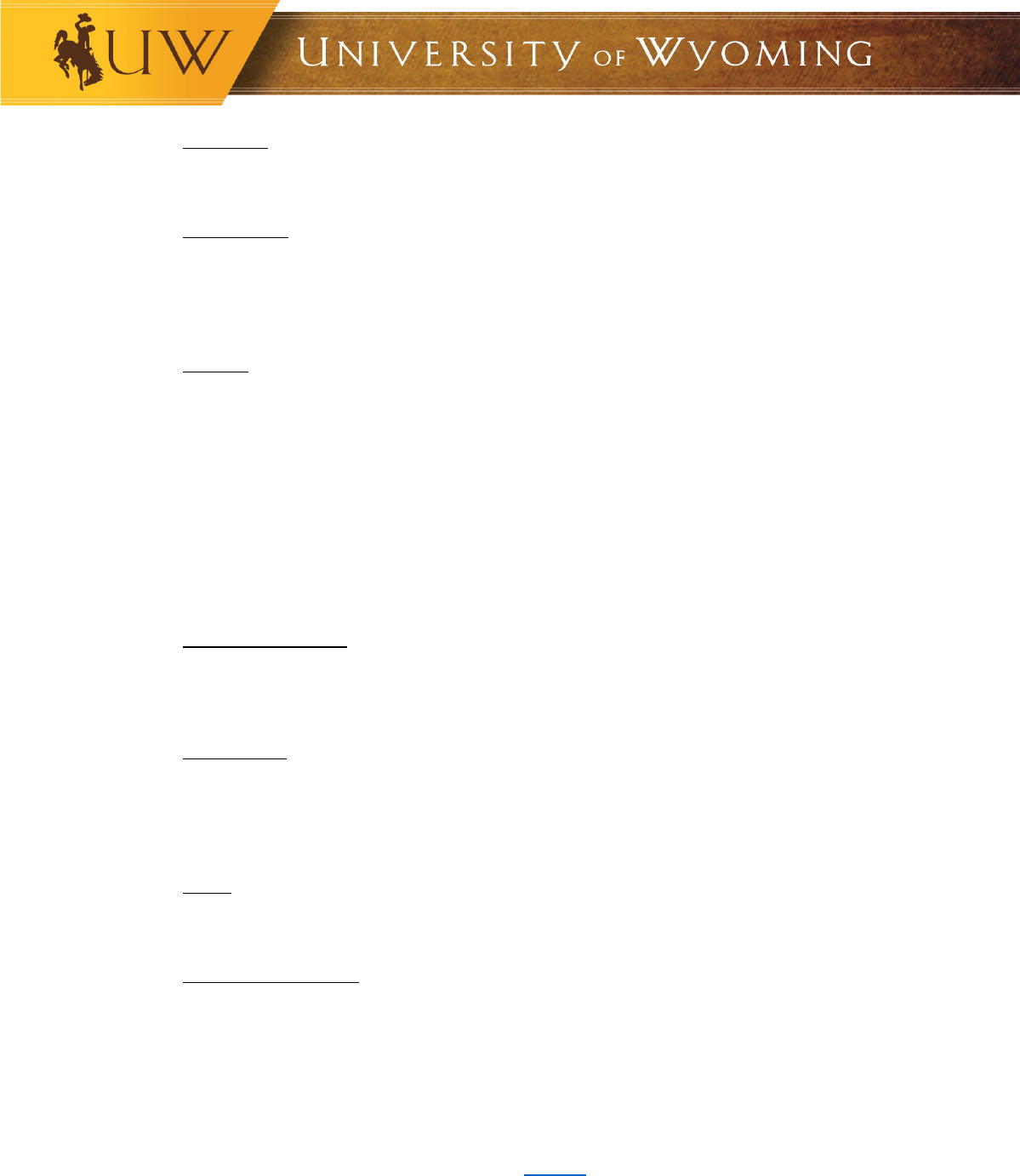
a) Cardholder
University employee or personnel authorized to make university purchases/commitments using
a u
niversity-issued P-card.
b) Change Order
A change needed to a purchase order that has already been dispatched to the supplier. This
change is initiated in the Financial Management System (WyoCloud). Appropriate changes to
a
p
urchase order can include: quantity, amount per unit or service, adding more lines, cancelling
lines, or changing the charge account information.
c) Contract
A contract is an agreement (oral or written) between two or more parties where there is a
mutual exchange of promises or other consideration upon defined terms and/or conditions.
Written contracts may take many forms including:
• Agreements for Services
• Letter of Agreement
• Purchase Orders
• Online Terms and Conditions
• Invoices
• Quote with a link to terms and conditions
d) Cost Center Approver
A designated university employee assigned responsibility to review and approve all transactions
affecting their organization’s budget. Typically, one of the first or second required approvals on
any expenditure.
e) Encumbrance
A commitment of university funds recorded when a purchase requisition is submitted and
approved in the Financial Management System (WyoCloud). An encumbrance is removed when
a corresponding invoice is entered into the system and the actual expense is recognized, or th
e
p
urchase order or line item is closed.
f) Goods
Supplies, materials, and equipment purchased by university departments. A good is a tangible
item, something that you can touch.
g) Honorarium/Honoraria
A gratuitous payment to a person (or business) for their participation in a “usual academic
activity*.” Typically, these are a “thank you” and appreciation made to a guest speaker o
r
l
ecturer that are not currently employed by the university and where there is no contractu
al
a
greement for payment. *There is a broad definition of usual academic activity that includes
lecturing, teaching, sharing knowledge, and meetings of boards or committees that benefit the
institution. It also includes performances, master classes and readings as long as there is not a
commercial nature to the events, and they are open to students and the general public free of
charge. The individual or business must be a Supplier
in the Financial Management System

(WyoCloud) and the Honorarium Form must be completed and attached to the Non-Catalog
Requisition.
h) Non-Catalog Requisition Shopping List
An option to add non-catalog items that are purchased regularly to a shopping list that can be
used each month (or however often) to create a new purchase requisition for the request. This
simplifies the process by decreasing the manual entry for the same items that are purchased
frequently.
i) Non-Catalog Requisition
The purchase requisition process of ordering goods and services not currently available in the
Procurement Catalogs. In addition to paying for goods and services, it is used to pay fo
r
i
ndependent contractors, honoraria, and stipends.
j) P-Card (Procurement Card)
A payment method where approved card holders are permitted to deal directly with suppliers
for purchases using a credit card issued by Procurement Services and to be used only for
university business. A pre-established credit limit is in place for each card issued. Purchases
made with the card must be in accordance with federal, state, and university statutes,
regulations, policies, and procedures. A p-card may be issued to a non-temporary university
employee, a university department, or issued as a ghost travel card to a department. The
fo
rmal name of the p-card is Procurement Card.
k) Procurement Agent
A person within the Procurement Services department duly authorized to review and approve
purchases on behalf of the University
.
l) Procurement Catalog Requisition
The purchase requisition process that utilizes pre-negotiated pricing through specifically
contracted and approved suppliers within WyoCloud
.
m) Purchase Order (PO)
Written document sent to a supplier formalizing terms and conditions of a proposed transaction
such as a description of the requested items, delivery of schedule, terms pf payment, and
transportation. Once a purchase requisition is approved, it automatically dispatches to the
supplier as a purchase order.
n) Purchase Order Life Cycle
The key milestones involved in ordering, obtaining, and paying for goods and services. The PO
life cycle allows the end user to track and monitor the purchase order and manage change
orders and cancellations. The PO life cycle ends when a purchase order has been fully received,
delivered, and invoiced. The status of the order will then change to closed or finally closed.
o) Purchase Requisition
Internal document used to request procurement of goods and services prior to entering into any
agreement with a supplier. When approved, the requisition becomes a purchase order. Two
options are available: Procurement Catalog Requisition and Non-Catalog Requisition.
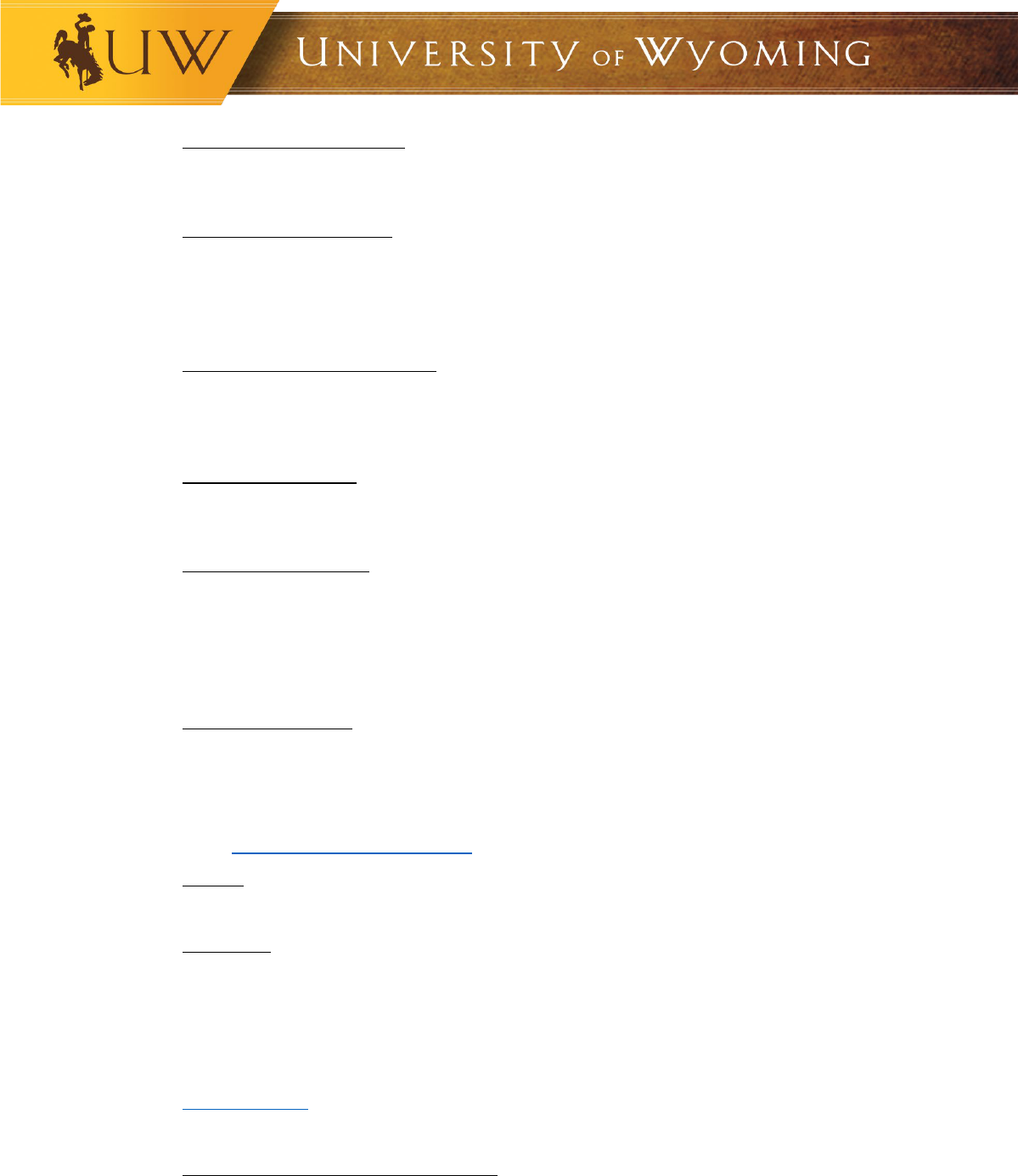
p) Request for Information (RFI)
A non-binding method used for gathering information and feedback from potential suppliers
prior to issuing a solicitation. Generally, price is not requested from suppliers.
q) Request for Proposals (RFP)
The document used to solicit proposals from potential providers (proposers) for goods and/or
services. Price is usually not a primary evaluation factor. Provides for the negotiation of all
terms, including price, prior to contract award. May include a provision for the negotiation of
best and final offers. May be a single-step or multi-step process.
r) Request for Qualifications (RFQu)
A document, which is issued by a procurement entity to obtain statements of the qualifications
of potential responders (development teams or consultants) to gauge potential competition in
the marketplace, prior to issuing the solicitation.
s) Invitation for Bids (IFB)
A procurement method to solicit competitive sealed bid responses, sometimes called a formal
bid, when other factors being equal, price is the basis for award.
t) Request for Quote (RFQ)
Purchasing method generally used for small orders under $99,999.99. A request is sent to
suppliers along with a description of the goods or services needed, and the supplier is asked to
respond with price and other information by a predetermined date. Evaluation and
recommendation for award should be based on the quotation that best meets price, quality,
delivery, service, past performance, and reliability.
u) Requisition Categories
Specifies a requisition’s purpose and is provided on the requisition, e.g. Capital Expenditures,
Educational and Recreational Supplies, and Equipment. Requisition Categories tie to Natural
Account numbers. To view the requisition categories currently available and the natural account
they are mapped to, view the Requisition Categories document on the Financial Affairs website
under Policies and Reference Material
within the Procurement area.
v) Services
Labor, time, or effort furnished by a supplier to the university.
w) Sole Source
A non-competitive method of procurement used when only one supplier possesses the unique
ability or capability to meet the particular requirements of the entity or because only one
supplier is practicably available. Procurement Services may require written justification (Sole
Source Justification Form) from the end user explaining why only this supplier can fulfill the
requirement.
x) Supplier/Vendor
An external provider of goods or services.
y) WyoCloud Financial Management System

The Financial Management and Human Capital Management System, typically referred to as
WyoCloud, is the university’s cloud-based finance, human resource, administrative, research
support, and reporting system.
III. Related Forms, Resources, and Departments
Procurement-Related Documents
Documents are Located on Financial Affairs Website within Policies & Reference Material or the Forms
Section
Document Name
Description
Procurement Services Manual
This manual outlines the procedures that govern purchases at the
university, including Authorized and Unauthorized Purchases, Gifts
and Gratuities, and Conflict of Interest.
Procurement Card (P-Card)
Policies and Procedures
Details the p-cards benefits, use, policies/procedures, and the
importance of reconciliation.
Quote and Bid Threshold,
Standard Administrative Policy
and Procedure (SAPP)
This SAPP outlines the threshold for which goods and services must
have solicited quotes, formal bids, or request for proposals in
compliance with university policy, state and federal law. The policy
applies regardless of the source of funds.
Purchase Order and Invoice
Tolerance Rules Department,
Administrative Policy and
Procedure (DAPP)
This DAPP provides an overview of how invoice matching on
purchase orders (POs) are handled by Payment Services and what
the tolerance limits are in processing payments for matching
discrepancies for overages
Capital Assets Purchases,
Business Process Guide (BPG)
This guide provides specific information and processes pertinent to
the purchase of university capital assets through the requisition
process.
Employee/Independent
Contractor Determination
Worksheet (EIC)
Used in the requisition process when processing a personal services
contract for an amount > $2,500. The worksheet determines the
status of the business relationship – university employee or
independent contractor.
Sole Source Justification Form
Provides justification request for the sole sourcing of goods or
services from a supplier. The form requires various approvals based
on dollar amount and is reviewed by the Procurement Services
Office.
Statement of Work (SOW)
Form
Utilized for service arrangements valued at $2,500 to $9,999 for
which the supplier does not require its own contract. The
Amendment to Statement of Work extends the timeframe or adjusts
compensation of the original document
Additional Documents
Dispute Form, Hosting or Business Event Form, Procurement Card
Reimbursement Form, Supplier Application, Substitute Receipt
Form, Tax Exemption Certificate, Travel Card Agreement Forms, etc.
All located within the Forms section of the Financial Affairs website.

Departments Involved with Procuring Goods/Services
Department
Role
Procurement Services
Organizes and administers a centralized purchasing function in
accordance with federal, state, and university regulations, policies,
and procedures. This includes purchasing, renting, leasing, or
otherwise acquiring any supplies, services, or goods: including all
functions that pertain to the acquisition including description of
requirements, selection and solicitation of sources, preparation and
award of contract.
Payment Services
Reviews and administers payments for invoices.
Office of General Counsel
(OGC)
Coordinates and supervises all legal services for the university by
providing timely legal guidance. Also, reviews and approves all
contractual agreements binding the university.
Risk Management Office
Responsible for overseeing insurance coverage, proof of insurance
requirements, and the processing of insurance claims for the
university. Will review contracts as needed for insurance purposes.
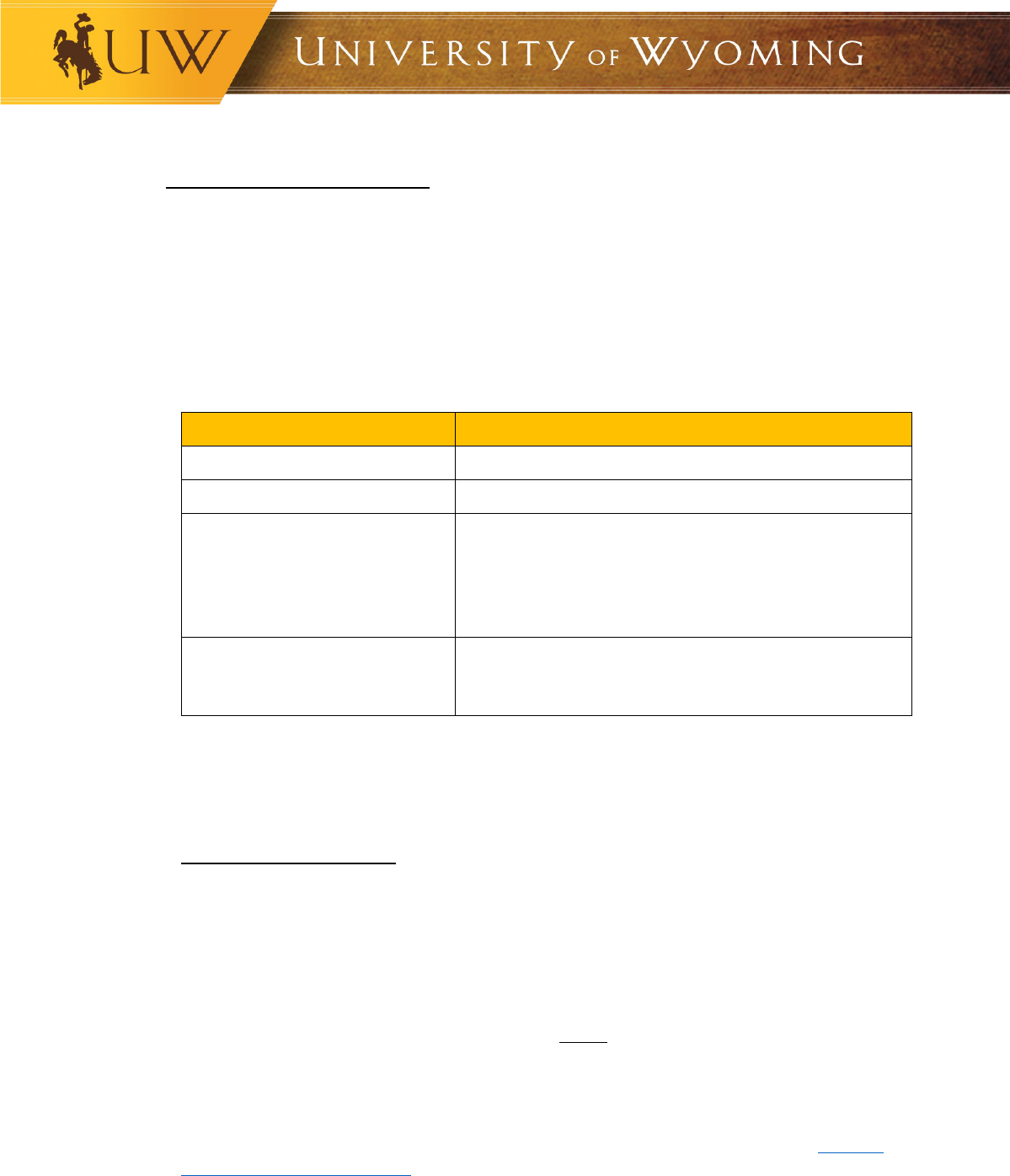
IV. Prerequisites for Purchases
1. Quote and Bid Threshold Policy
Prior to purchasing goods or services on behalf of the university, employees must review the
Quote and Bid Threshold policy to assess if additional documentation is needed prior to
purchasing or agreeing to terms. This policy is based on the commitment amount of the purchase.
These documents must be obtained and approved prior to making the purchase or submitting the
request for the purchase.
Once obtained, these documents must be attached during the required purchasing process, such
as a Purchase Order.
Purchase Amount
Services and/or Goods
0-$4,999.99
At least one documented quote
1
$4,999.99-$9,999.99
At least one documented quote
$10,000-$99,999.99
1) At least two supplier quotes
2
,
OR
2) Bid/Request for Proposal documentation
3
,
OR
3) Sole source justification
4
$100,000+
1) Bid/Request for Proposal
3
OR
2) Sole source justification
4
1
Not required if allowable and processed on a Procurement Card or Non-PO Invoice
2
Obtained by department
3
Obtained by Procurement and Payment Services
4
All sole source requests must be approved by Procurement and Payment Services
2. Contract and Agreements
After a university employee ensures all documentation is obtained and approved per the Quote
and Bid Threshold Policy, the next step is to identify if a contract must be completed to bind the
university and the supplier. Other documents may be required to be completed based on the
commitment amount of the purchase and type of purchase.
If the purchase is for services, a combination of goods and services, or if the supplier requires
an external contract, the employee must submit a contract for approval through the Contracts
Module within the Financial Management System PRIOR to agreeing to any terms and
proceeding with the purchase.
The following diagram outlines the documents and when a contract is required based on the
type of purchase and the dollar amounts.
Access to the Contracts Module requires separate training to be completed. See the
Financial
Management Training website for training requirements. Additionally, the following Quick
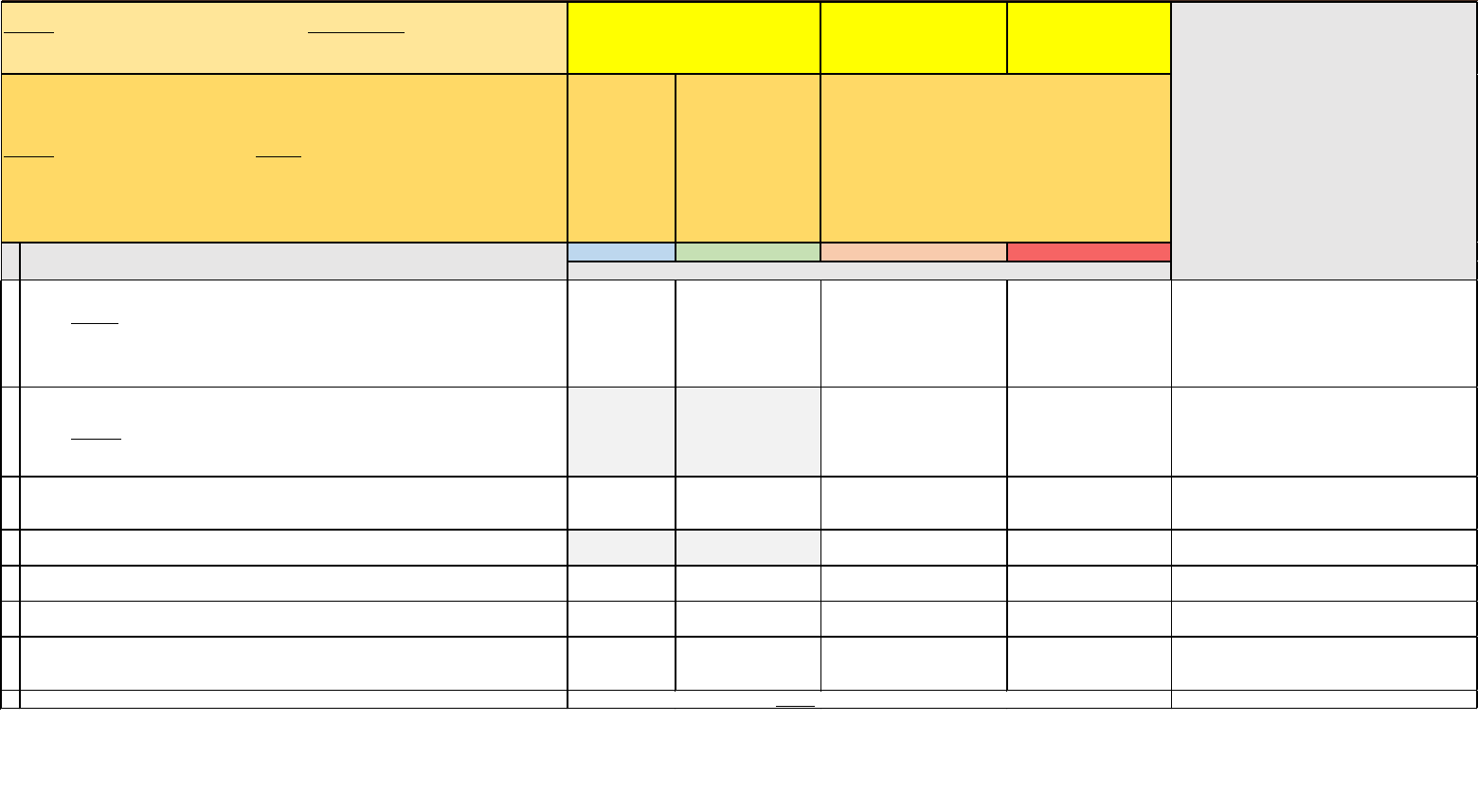
Summary of Required Documents based on Quote & Bid Threshold Policy & Contracts
1) Two Separate Supplier
Quotes, or
2) Bid/Request for Proposal, or
3) Sole Source Justification
1) Bid/Request for Proposal,
or
2) Sole Source Justification
(1) Supplier
Documentation &
(2) Employee
Independent
Contractor (E/IC)
Determination
Worksheet
(1) Supplier
Documentation, (2)
Employee Independent
Contractor (E/IC)
Determination
Worksheet, & (3)
Statement of Work Form
or Agreement of Services
Form
2
$0- $4,999 $5,000-$9,999 $10,000 - $99,999 $100,000 +
1
Supplier Requires External Contract (Service and Software License Agreements, Excludes Goods).
Only need the suppliers contract and our addedum. Complete fields in WyoCloud per QRG and
attach pdf of supplier contract.
Y Y Y Y
Many different forms including: An invoice or quote
with binding conditions (usually in very small print or
provided as a link); separate page that includes terms
and conditions (even if no signature required); letter
of agreement; purchase order; or formal agreement
for service.
2
Supplier Does Not Require its own External Contract (Services Only, Excludes Goods) Y Y
Agreement for Services template can be used for any
amount, and for certain services valued at less than
$10,000. If used, the template must be completed and
submitted for review through the WyoCloud Contracts
Module.
3 Goods and Services are Combined (Treated as a Service, Follow Items 1 or 2 above) Y Y Y Y
Contract process required depending if the supplier
requires or does not require an external contract and
also based on amount.
4 Hotel Agreements Y ($20,000+) Y
Hotel agreements under $20,000 must be approved by
Procurement and Payment Services.
5 Facilities Use/Rental agreements Y Y Y Y
All rental agreements or use of non-uw facilities,
requires the contract process.
6 Memorandum of Understandings (MOUs) Y Y Y Y
Either UW template or supplier template, even for no
money, must go through the contract process.
7 Technology Purchases Y Y Y Y
Utilizing the Procurement Catalog through CDW-G or
ordering Apple Products through UW Bookstore does
not require the contract process.
8 Agreements between UW Departments
#
UW departments do not need develop contracts between each other
Required Documents per Quote & Bid Threshold Policy Goods & Services
: PreRequisities Prior to
Starting the Contract Process (*based on the dollar limits outlined below)
1
Required
Documents per Contract Process for Services Only (*all documents listed are required for
their dollar limit section)
1) Any Itemized Documentation Showing
Cost and Description
Contract Process Required ( Y= Yes, Blank = No)
Description
Notes
(1) Supplier Documentation, (2) Employee Independent
Contractor (E/IC) Determination Worksheet, & (3) All
Agreement of Services Form
1
The purchase of Goods only do not need to go through the contract process; however, based on the cost of the good (over $10k), additional information is needed to be gathered prior to the commitment of purchasing.
2
Certain situations require an Agreement of Services form instead of a Statement of Work form on the UW template to be completed.
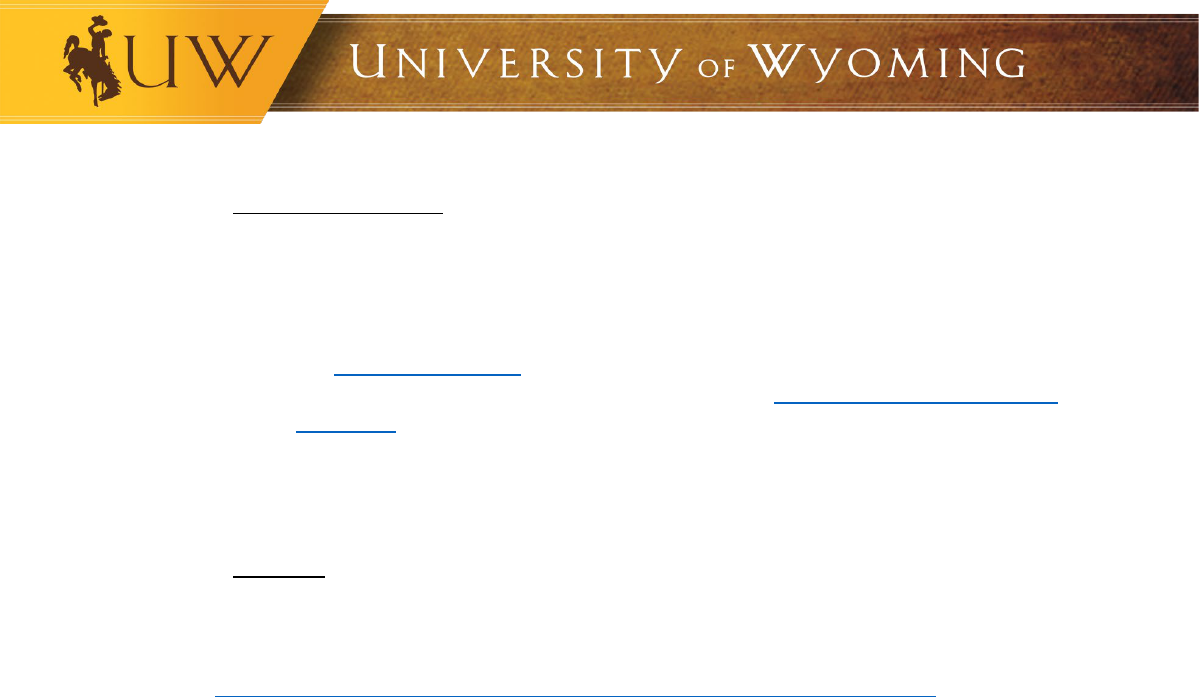
3. Catering Agreements
If a department is entering into a catering agreement, there are a few things to note:
• Some caterers have been authorized to perform catering for all departments on
campus, including the Wyoming Union and have furnished all their necessary
paperwork, which includes proof of insurance and a food permit or restaurant license.
See Catering Information
for a list of these caterers.
• Caterers not currently authorized must complete the University of Wyoming Catering
Agreement for Procurement Service’s approval.
• The UW Catering Guidelines for Off-Campus Activities provides additional guidelines
for R&E Centers and other off-campus entities/events. See Appendix I.
• University Catering should be given first rights of refusal.
4. Suppliers
Prior to submitting a contract through the Contracts Module or submitting a request for
purchase or payment, the supplier must be setup in the Financial Management System. To
determine if a supplier is currently setup or to set up a new supplier, users should follow the
Looking up Current Suppliers or Setting up New Suppliers Quick Reference Guide
.
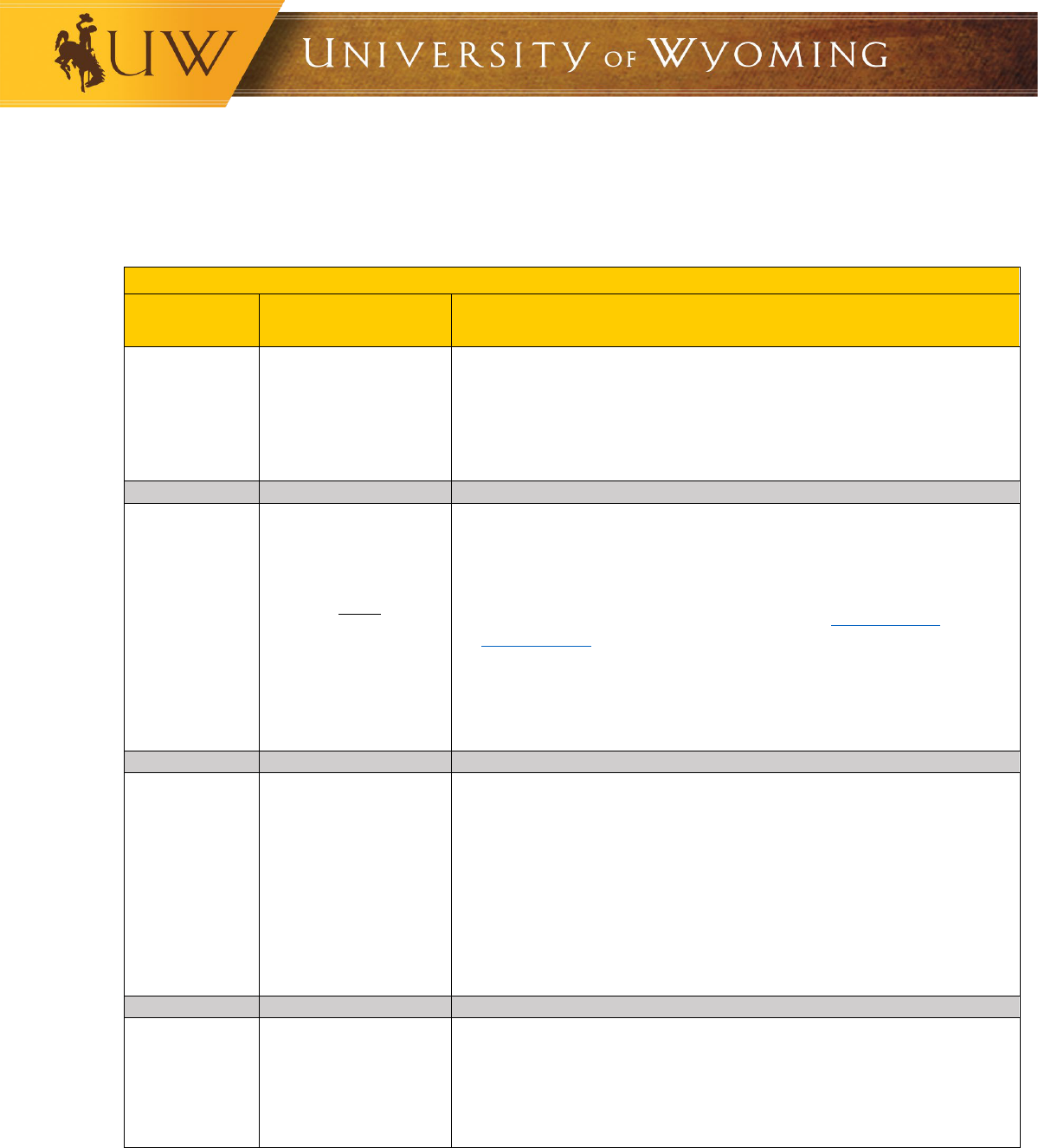
V. Purchasing Methods Overview, Effective July 1, 2021
Once those prerequisites are determined, the request for purchase of the goods/services can be
completed. Below is an overview of the purchasing methods at the University of Wyoming:
Purchasing Methods Overview
Procurement
Method
$ Amount
Notes
Procurement
Card (P-Card)
Max Transaction Limit =
$4,999
Total Monthly Limit =
$7,500
• Ease of use for simple procurements
• Individual, Department, and Travel Cards available
• Tax exemption accounts set up for Office Depot and Amazon Business
Prime purchases
• Mandatory 30-day reconciliation process or hold will be placed on the
card.
Non-PO Invoice
Invoices under $5,000
*Exceptions apply
• Ease of use to pay for goods/services that do not require procurement
approval through the purchase requisition/purchase order process
• Exceptions apply to the $5,000 threshold and the
Non-PO Invoice
Processing QRG outlines these exceptions.
• Invoice must be attached when processing through the approval workflow
in WyoCloud
Procurement
Catalog
Requisition
Any dollar amount
• Ease of use/one-stop for purchases of office supplies, lab supplies,
furniture, and computers with negotiated prices that provide cost savings.
• Check out process is simple and automatically generates a requisition to
review prior to submission for approval.
• Purchasing a capital asset (per unit cost of $5,000+) via this method, users
must complete the asset fields in the purchase requisition fields and
contact Asset Management immediately after placing the order.
Non-Catalog
Purchase
Requisition
Any dollar amount
• Used for purchasing goods/services not available in Procurement Catalogs
or those that are not allowable via any other payment methods.
• Purchasing a capital asset, users must follow the Capital Asset Business
Process Guidelines apply for purchases > $5,000 and the Quote and Bid
Threshold policy.
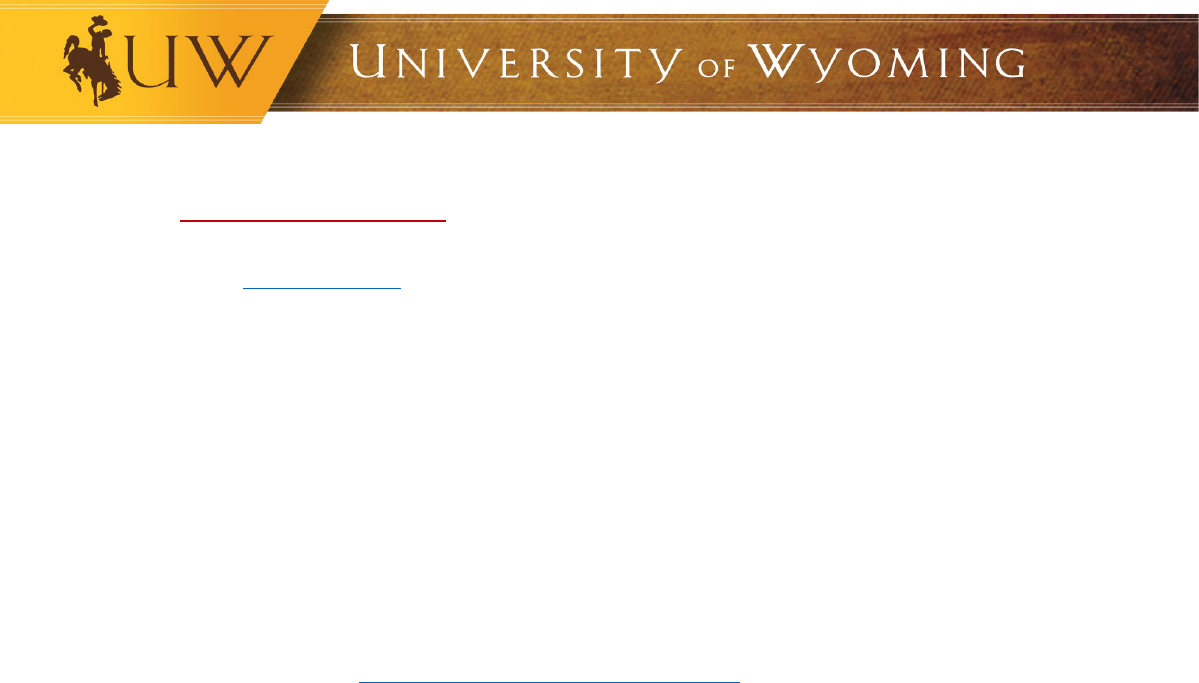
VI. Purchasing Methods Explained
Procurement Card (P-Card)
The university p-card program is a credit card program administered by the Procurement Services
Office, [email protected]. P-Cards offer a simple, streamlined method of purchasing for the
University of Wyoming.
a) Governing document detailing allowable and prohibited uses, and procedures:
• Procurement Card Policies and Procedures
b) Type of P-Cards
• Individual
o Issued in the individual’s name
o Individual responsible for all card activity and ensuring transactions are
reconciled within 30 days
o Individual can delegate another employee to reconcile transactions within
WyoCloud
o Used for any expense that falls under the allowable items within the
Procurement Card Policies and Procedures unless restricted by the
college/department
o Monthly limit of $7,500 and single transaction limit of $4,999
• Department
o Cards are issued in Department or Lab’s Name
o Works well for labs or departments with employees who don’t purchase items
often and don’t need a permanent individual card
o Tied to an individual in WyoCloud for reconciling within 30 days
o Labs and Departments may request multiple cards for their area
o Check out process managed by the individual tied to the card in WyoCloud
o *Cannot* be used for travel expenses
o Used for purchasing goods/services on behalf of the department
o Monthly limit of $7,500 and transaction limit of $4,999
• Travel (Ghost) Card
o There is no physical card, only a card number on a paper sheet
o Each department may have one central travel card in the department’s name
o Tied to an individual in WyoCloud for reconciling. This individual is responsible
for the validity of the purchases and the travel card should be limited to who
has access to the card
o Used *only for* travel expenses: hotel, commercial transportation, baggag
e
f
ees, etc.
o For employees that travel occasionally and don’t need an individual card
o The Travel Card can be used by a Travel Agent or on the internet (Please ensure,
in advance, that a supplier will accept the “ghost” travel card. The Procurement
department can provide an authorization letter to the supplier if necessary, o
n a
cas
e-by-case basis)
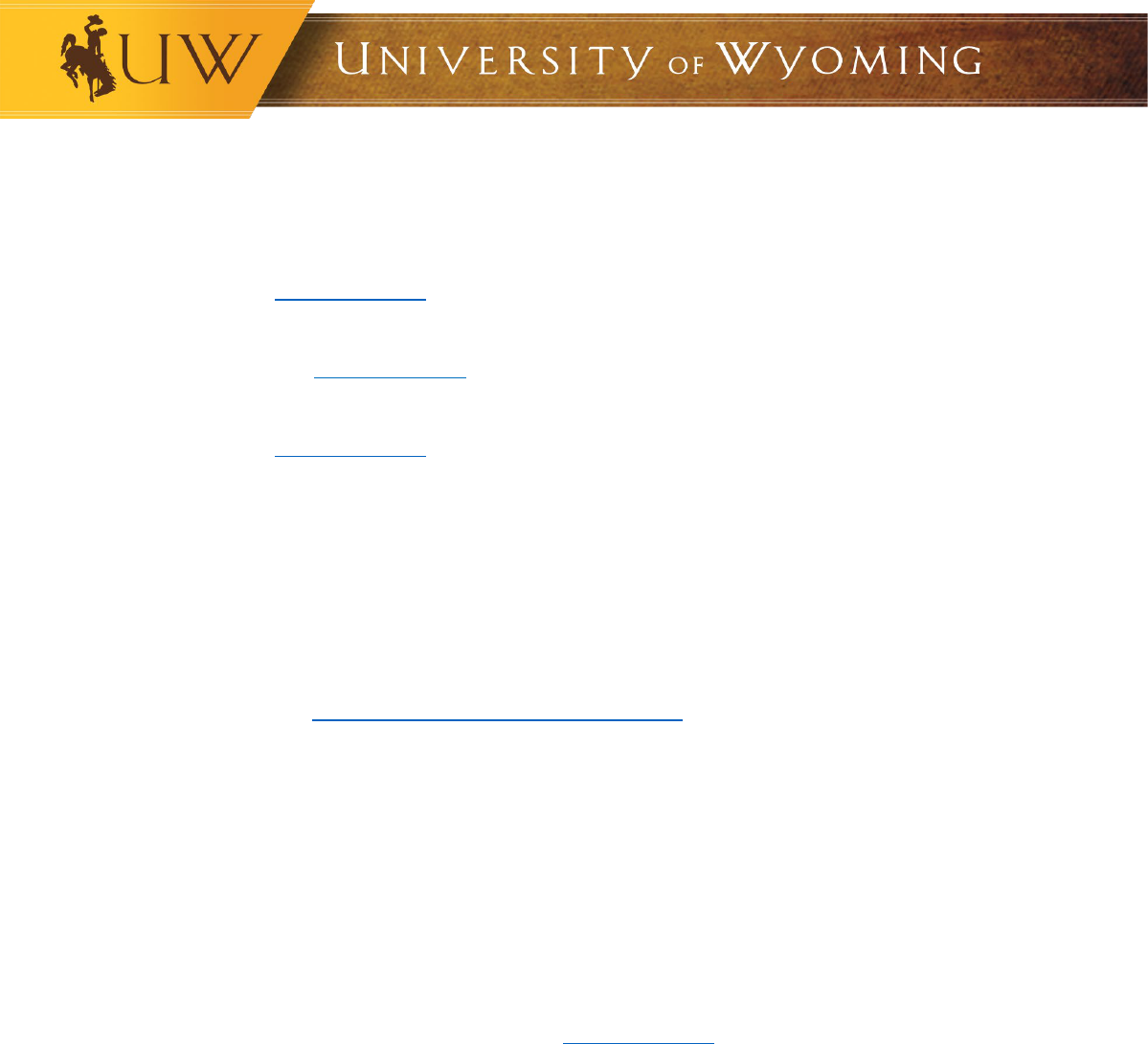
o Travel cards have a single transaction limit of $9,999 and have a higher
starting cycle limit of $15,000 compared to individual or department cards.
c) Obtaining a P-Card
• Individuals: Complete the Procurement Card Agreement Form, Individual and email it to
[email protected]. Upon approval of the request, cardholders must successfully
complete the online p-card training before receiving the card.
• Department: Complete the Procurement Card Agreement Form, Department and email
it to p[email protected]. Upon approval of the request, individuals responsible for the
card must successfully complete the online p-card training before receiving the card.
• Travel (Ghost) Card: Complete the Travel Card Agreement Form and email it to
[email protected]. Upon approval of the request, the Department Travel Card Manager
must successfully complete the online p-card training before receiving the card.
ci) Transaction Processing, Roles/Responsibilities, Card Cancellation, Card Misuse
• Detailed information about these and other topics may be found in the Procurement
Card Policies and Procedures.
cii) P-Card Reconciliation Process
• Posted p-card transactions are uploaded daily to the Expenses Module in the Financial
Management System.
• The P-Card Expense Reconciling/Reporting QRG includes step-by-step instructions for
the reconciliation
process.
• All p-card transactions must be reconciled within 30 days of the posted date. P-Cards
with transactions that have not been reconciled within 30 days of the posted date will be
temporarily suspended from use until those transactions in question are reconciled, and
the Expense Report submitted, approved by all required approvers, and paid.
ciii) Amazon Business Prime
• Amazon Business Prime offers free shipping on many items used for university business
purposes, advanced analytics and dashboards, centralized tax exemption, and business
pricing and quantity discounts.
• If your department does not have an amazon business prime account and you would
like to request one, please email [email protected]. All accounts must be setup by the
Procurement Services department. Departments should not setup their own business
accounts.
• Although it is preferred that departments order goods through the university’s
Procurement Catalog suppliers (Office Depot, CDW-G, Fastenal, Fisher Scientific, and
Fisher Chemical) the university understands that there are circumstances where
departments will save dollars by using Amazon Business Prime.
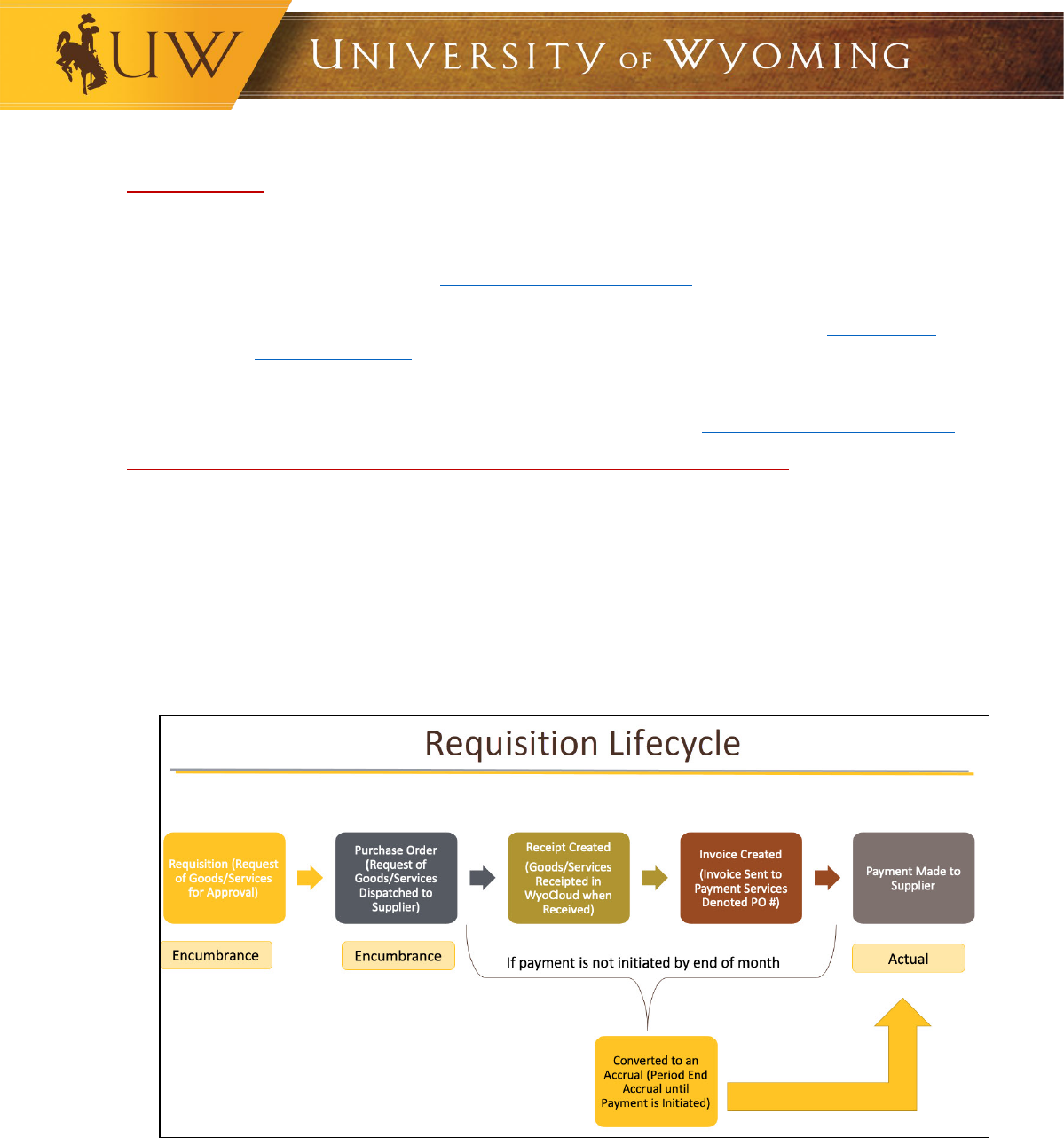
Non-PO Invoice
Used for purchases under $5,000 that do not require multi-level approval through the purchase
requisition/purchase order process in WyoCloud.
• Exceptions apply – See Non-PO Invoice Processing QRG
for further information.
• Invoice must be attached when processing through the approval workflow in WyoCloud.
• If the remit address is not currently listed in the supplier’s profile, email
new-supplier-
request@uwyo.edu to have the supplier profile updated.
• Office supplies, lab supplies & computers should be purchased through the
P
rocurement Catalog when available and at a competitive cost.
• Step-by-Step processing instructions are detailed in the Non-PO Invoice Processing QRG
Purchase Requisitions: Procurement Catalog and Non-Catalog Requisitions
The Purchase Requisition Process is the standard mechanism for the ordering of goods and services in
WyoCloud.
• There are two types of requisitions that are processed through WyoCloud:
1. Procurement Catalog Requisition Process
2. Non-Catalog Requisition Process
Both types of requisitions result in the issuance of a Purchase Order and the lifecycle is the same for
both processes:
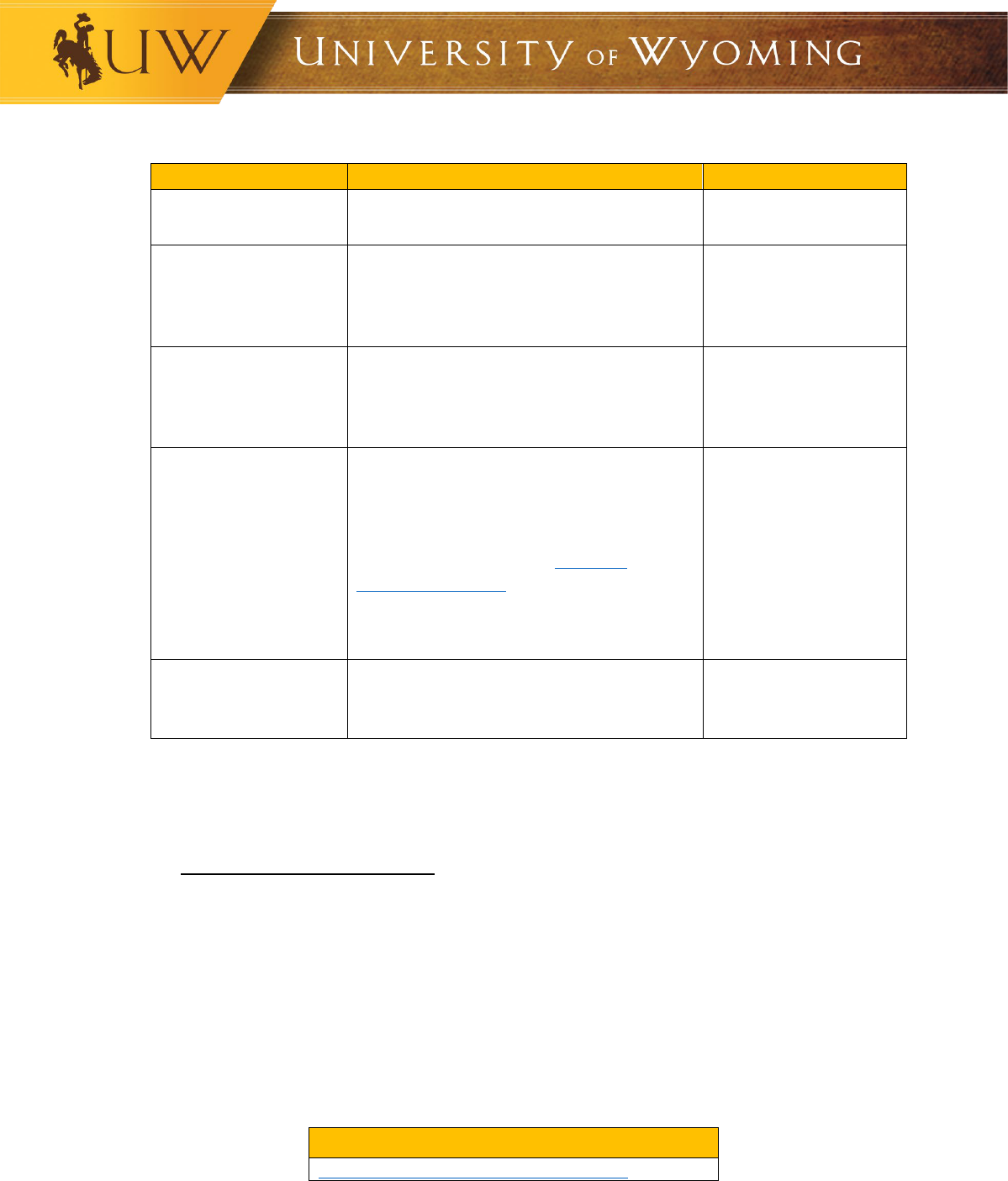
Stage of Lifecycle
Stage Description
Completed By
Purchase Requisition
1
Requesting approval to purchase
goods/services on behalf of the university
Submitted by
department personnel
Purchase Order
Automatically converted to a PO after all
approvals are completed on the purchase
requisition. The PO is automatically
dispatched to the supplier
System Generated
Receipt (Receiving of
Goods/Services)
When goods are received or services are
completed, the purchase requisition must
be received for ONLY the portion
delivered/completed.
Receipted in WyoCloud
by the requester or
person who completed
the requisition
Invoice
Procurement catalog invoices are typically
automatically sent to Payment Services
upon delivery.
Non-catalog requisition invoices must be
sent to Payment Services (
accounts-
payable@uwyo.edu) denoted the PO # on it.
Payment Services will match the invoices to
the POs in the system.
System generated for
catalog requisitions or
sent by department
personnel if they receive
the invoice
Payment
Purchase requisition must be both receipted
and invoiced matched for the system to
generate payment.
System generated
1
Depending on the amount and type of purchase, prerequisites are required prior to submitting
a purchase requisition. These prerequisites are outlined in section VI Contracts and Agreements.
1. Procurement Catalog Requisition
The Procurement Catalog Requisition process is a streamlined requisition process with the ease
o
f use attributed to the integration of suppliers’ catalogs in WyoCloud and the university’s
contractual price agreements with the suppliers. This is the preferred method of purchasin
g
s
pecific goods such as:
• Computers and peripherals (CDW-G)
• Office Supplies (Office Depot)
• Lab Supplies (Fisher Scientific)
• Lab Chemical Supplies (Fisher Chemicals)
• Construction, Industrial and Safety Products (Fastenal)
Quick Reference Guides
Create Procurement Catalogs Requisition
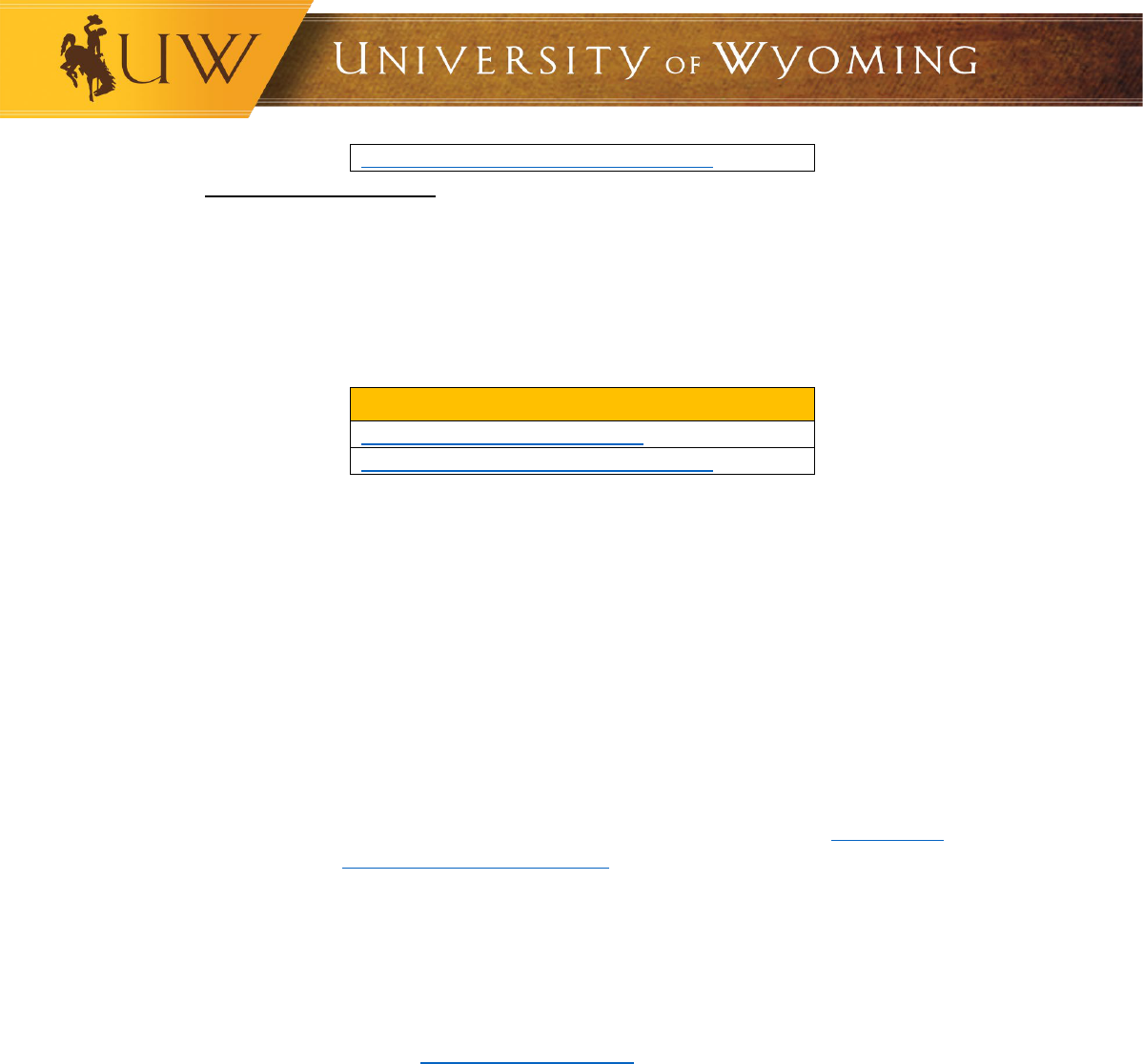
Capital Asset Business Process Guidelines
2. Non-Catalog Requisition
The non-catalog requisition process is for the request to purchase goods or services that are not
av
ailable through the procurement catalog. Non-catalog requisitions must be used for purchases
that are not allowed on non-po invoices or p-cards. Additional forms and approvals may be
needed depending on the type of purchase. See Section VI below
.
T
his process is always used when issuing contracts, honorariums, and certain requisition
categories regardless of dollar amount.
Quick Reference Guides
Create a Non-Catalog Requisition
Capital Asset Business Process Guidelines
3. P
urchase of Multiple Pieces that Comprise One Unit
a. Purchase Orders that involve separate “pieces” that comprise one unit, e.g., desk uni
t
w
ith desk, shelves and drawers, may be entered on one WyoCloud Requisition Line
versus multiple lines.
b. If multiple lines on a supplier quote comprise one complete capital asset, they should b
e
e
ntered as one line item on the requisition. Otherwise, the supplier quote should match
the line items on the requisition
4. C
hanges to Requisitions or Purchase Orders
a. Change of Requestor on Requisition in an Open Status
i. Occasionally, an employee may need to transfer open requisitions/POs to
another employee due to leaving the university or transferring departments.
ii. To transfers all requisitions, the employee can follow the
Changing the
Requestor on Requisitions QRG. This process moves all requisitions from one
requestor to another.
iii. If the mass requestor change function is not an option (i.e., requestor has done
requisitions for various departments) and only a handful of open requisitions
needs to be changed, the Procurement Services
department can manually
change each requisition requestor. Please contact them with this request,
including the requisition number and who the new requestor should be, by
emailing procurement@uwyo.edu.
b. Changing/Cancelling an Approved Purchase Requisition/Purchase Order
i. There are many circumstances where changes are needed to an approved
Requisition that has been dispatched as a Purchase Order that is still open.
Some examples include:
• Quantity changes
• Amount changes
• Adding additional lines or canceling lines
• Charge account string or project number needs changed
• Removing an encumbrance
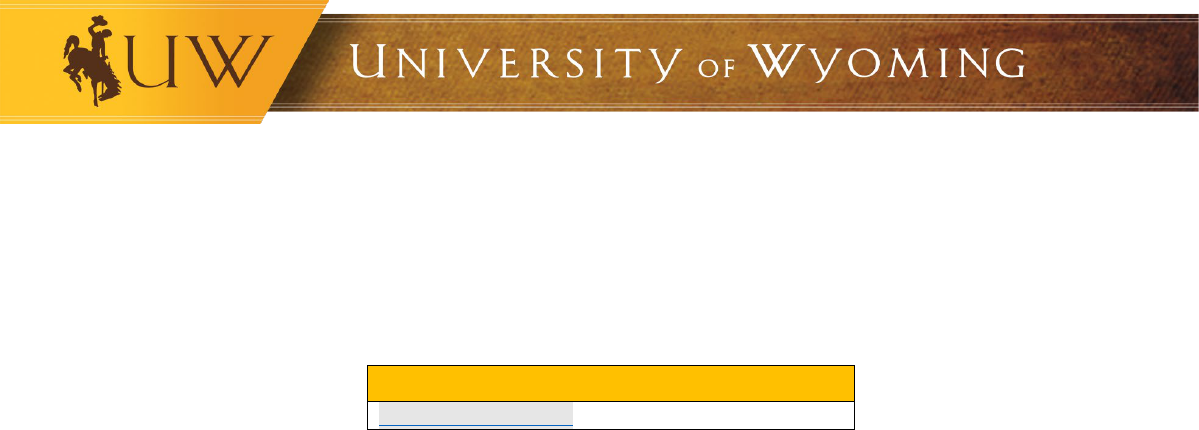
ii. Depending on the type of change needed, some will route through the approval
workflow (ex. change to the amount) and others will not need to go through
approval (removing an encumbrance).
iii. Purchase orders must reach a Closed or Finally Closed status; otherwise, the
encumbrance will continue to be carried forward on that organization
’s
account. (Note: Finally Close status means that Procurement had to manually
close the Purchase Order to remove an outlying encumbrance).
Quick Reference Guides
Edit a Purchase Order

VII. Appendices
Appendix I
1. UW Catering: Guidelines for Off-Campus Activities
Reimbursement for groceries:
UW employees can purchase groceries and prepare food at a UW facility for a UW-sponsored event for
the general public and/or invited guests.
Often when food is served at a UW function it is catered and it is necessary to use an authorized
caterer. Food that is ordered from a restaurant or caterer for a UW-sponsored event will be reimbursed
only for caterers on the authorized list. This is regardless of whether the food is delivered or if a UW
employee picks it up.
• Example:
o Muffins from the grocery store that are sold for the general public do not require an
authorized caterer. A Hosting form is required.
o Muffins custom ordered from a bakery requires an authorized caterer. A Hosting form is
required.
• Example:
o Ordering from the menu where you eat in the restaurant does not require an authorized
caterer. A Hosting Document is required for all forms of payment; personal
reimbursement, p-card, or requisition.
o Ordering food from a restaurant and bringing it back to a UW event does require an
authorized caterer. If the employee is using a personal vehicle, this falls under the UW
Private Vehicle Use Policy. A Hosting form is required.
The steps to become an authorized caterer may take time to complete so begin several weeks prior to
the event. To become an authorized caterer, a food vender must complete the following steps:
• Complete the Catering Agreement http://www.uwyo.edu/procurement/catering-information/.
This agreement is designed for both on-campus and off-campus catering.
• Complete the Supplier Self-Registration if not an existing supplier in WyoCloud.
https://www.uwyo.edu/procurement/supplier-guide/index.html
• Provide a copy of Restaurant License or Food Permit issued by the Wyoming Department of
Agriculture. In some circumstances, a temporary permit issued is
by the overseeing city or the
appropriate authorized agency outside of the State of Wyoming.
• Provide a copy of Certificates of Insurance and original endorsements showing the amount of
business coverage.
• If food is being delivered by the caterer, a copy of automobile liability insurance will also be
required.
• If alcohol is being served, a copy of liquor liability insurance is required.

Benefits of being on the list of authorized caterers:
• Caterer agreements are for a set two-year period which means an authorized caterer will be on
the list for two years or less depending when they are approved during the designated period.
UW Procurement will contact authorized caterers when their food license and insurance expire
to obtain new copies. If they don’t supply these pieces of information they will be removed from
the authorized caterer list. At the end of the contract term, UW Procurement will contact the
current authorize caterers for renewal of the contract. It is responsibility of the caterer to
submit all required documents to be put on or remain on the authorized list.
• Once a caterer is on the authorized list, all UW entities can utilize that caterer.
Other important items:
• Insurance coverages are listed in the Catering Agreement. Limits are consistent with most
business insurance policies. Caterers with different insurance limits are requested to provide
insurance documentation to be reviewed by UW Risk Management for possible exceptions.
• Employees transporting and/or preparing food for UW-sponsored events are encouraged to
participate in safe food handling training.
• Outside entities using UW facilities should complete a Facilities Use Agreement that includes
terms and conditions transferring liability to the user. Office of General Counsel can assist. No
templates currently available.
• If expenses have followed these guidelines and are rejected, follow up with Procurement, Risk
Management, and/or General Counsel is encouraged. Risk Management can assist with this
process.
• UW employees are allowed to purchase and prepare food for both employee-only and
employee and public events subject to procurement rules and your budget. Food should be
prepared using UW facilities and not brought from home.
Prepared 11/26/18 by Mary Kay Wardlaw, Associate Director for UW Extension in consultation with UW
Procurement, General Counsel and Risk Management.
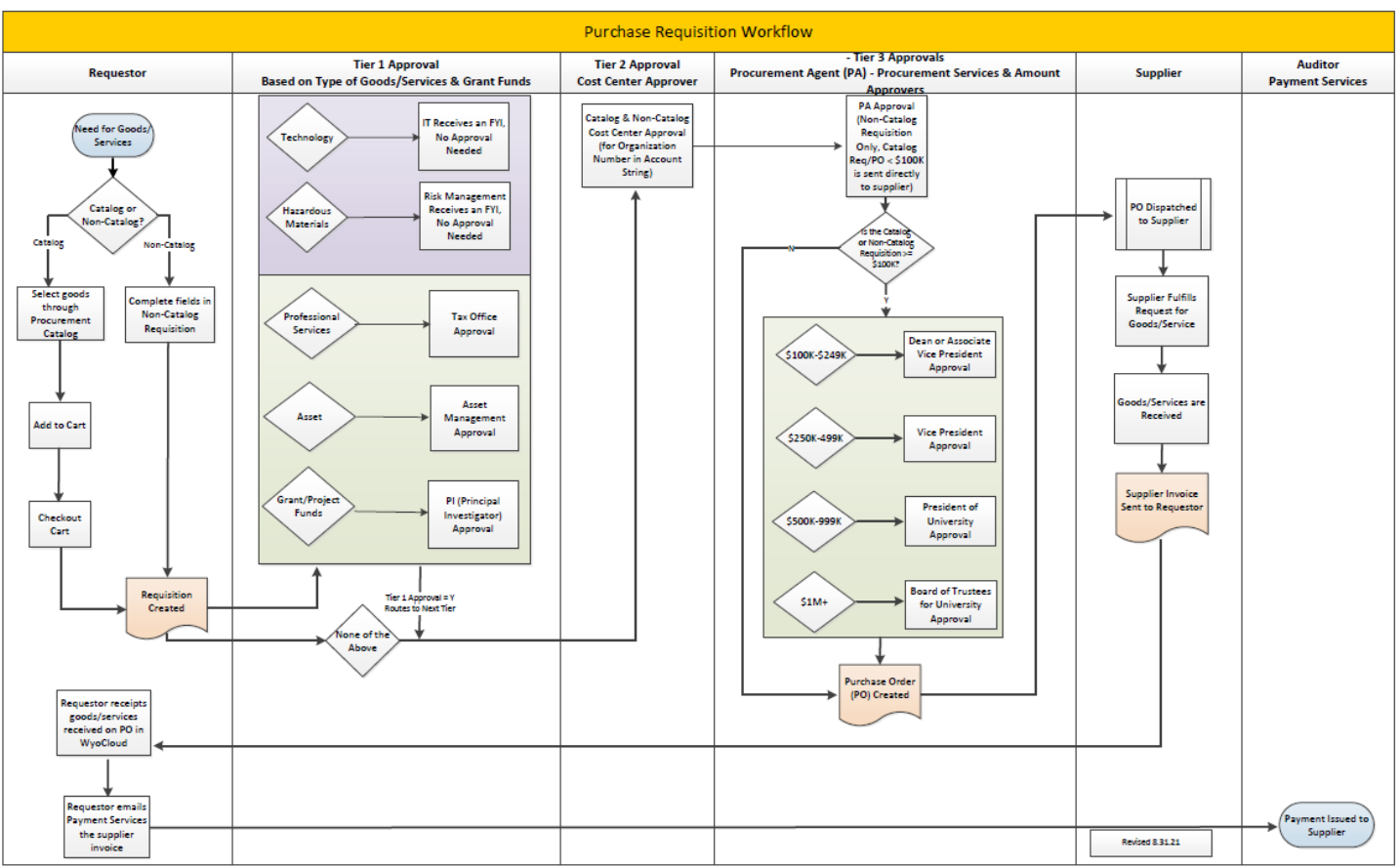
Appendix II
2. Purchase Requisition Approval Workflow
The End of This Business Process Guide

